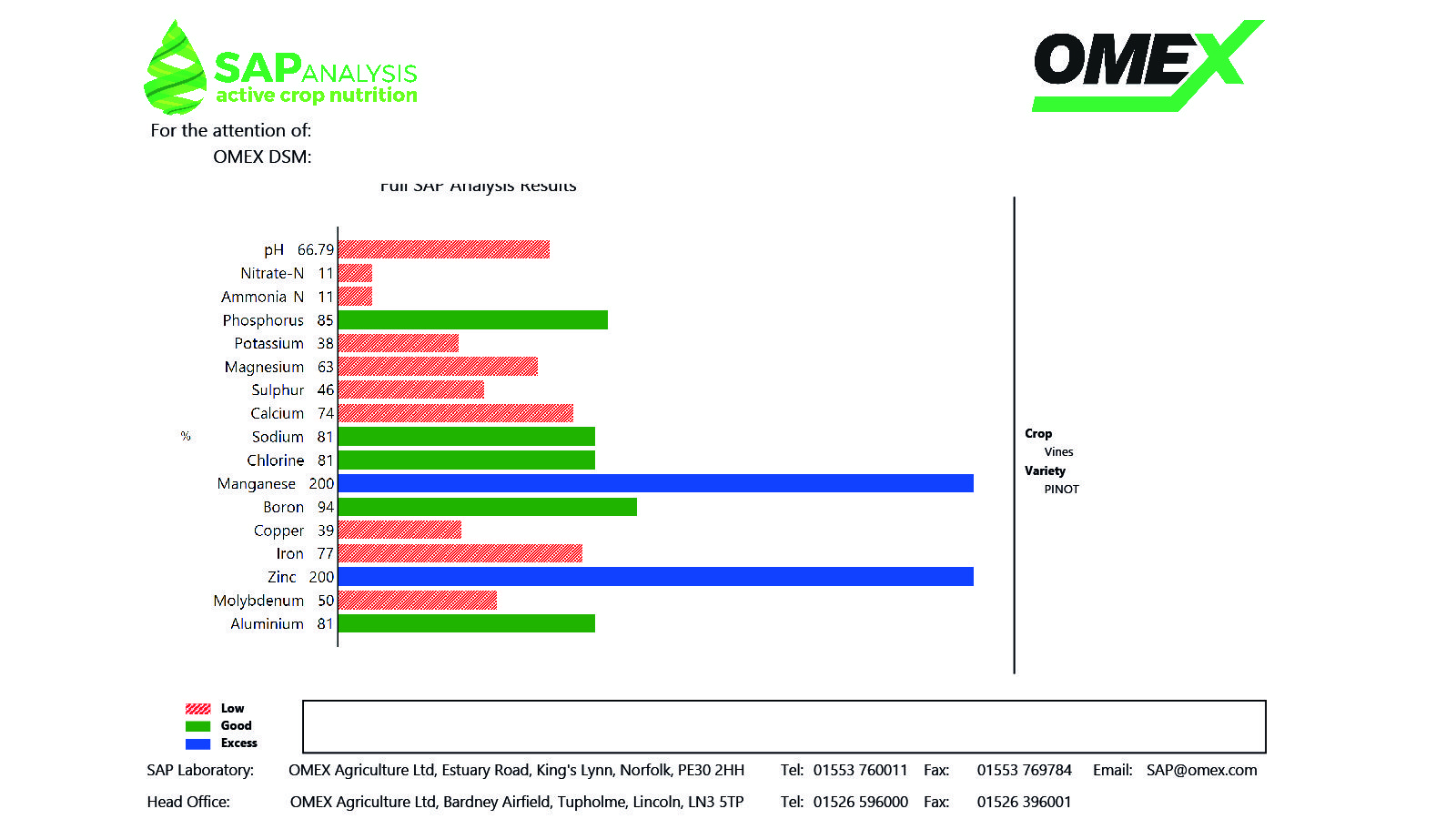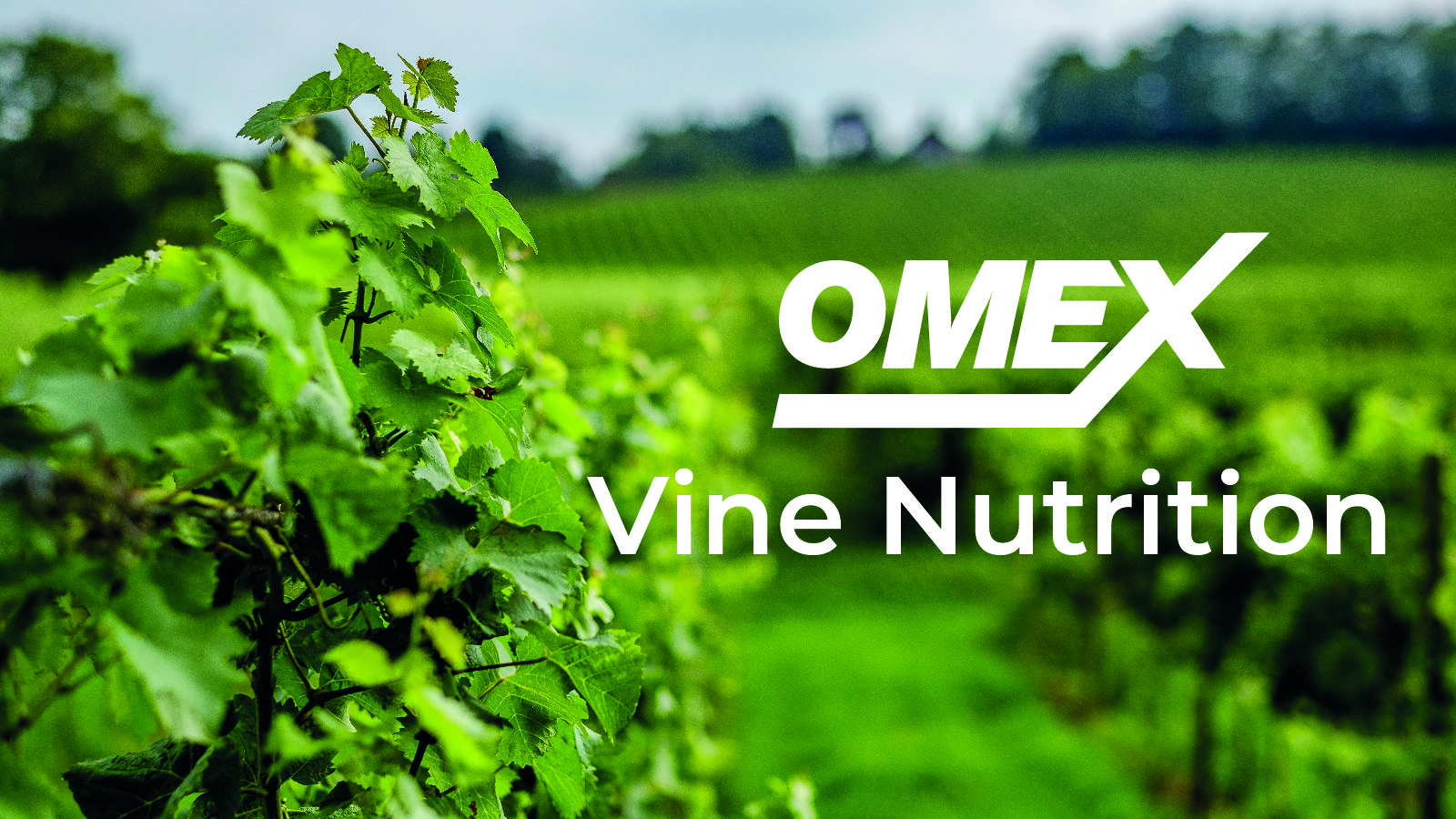In the latest OMEX technical update Agronomist, Neil Holmes, and Technical Manager, Joe Barfoot, discuss nutrition for vines.
 OMEX Agronomist, Neil Holmes
OMEX are well placed to provide nutrition for vines with a wide range of liquid base fertilisers, foliar nutrition and unique plant health support products, including organic approved. Our team of technical managers and agronomist understand the uniqueness of each crop and each growing situation, so the initial step for any grower is using SAP analysis. SAP analysis looks at the nutrition actively available to the crop, not nutrition that is locked up unavailable for growth, giving the grower a thorough understanding of how best to proceed, eliminating over or under applying nutrition. The below chart demonstrates how the results of SAP analysis are shown to the grower, alongside agronomist comments to ensure you make the best nutritional choice going forward.
OMEX Agronomist, Neil Holmes
OMEX are well placed to provide nutrition for vines with a wide range of liquid base fertilisers, foliar nutrition and unique plant health support products, including organic approved. Our team of technical managers and agronomist understand the uniqueness of each crop and each growing situation, so the initial step for any grower is using SAP analysis. SAP analysis looks at the nutrition actively available to the crop, not nutrition that is locked up unavailable for growth, giving the grower a thorough understanding of how best to proceed, eliminating over or under applying nutrition. The below chart demonstrates how the results of SAP analysis are shown to the grower, alongside agronomist comments to ensure you make the best nutritional choice going forward.
 OMEX SAP Analysis Chart
OMEX SAP Analysis Chart
 Vines growing with OMEX
Vines growing with OMEX
Establishing nutrition for vines
The popularity of vine growing is rapidly increasing in the UK horticultural industry, as is the variety of growing approaches to take. From conventional, organic, biodynamic, regenerative or a combination approach, we're seeing a wonderfully dynamic range of growers producing fantastic UK wines. With such a broad array of growing approaches to consider, many new to the crop can become unsure about how best to provide nutrition for their vines to produce a high quality yield. OMEX Agronomist, Neil Holmes
OMEX are well placed to provide nutrition for vines with a wide range of liquid base fertilisers, foliar nutrition and unique plant health support products, including organic approved. Our team of technical managers and agronomist understand the uniqueness of each crop and each growing situation, so the initial step for any grower is using SAP analysis. SAP analysis looks at the nutrition actively available to the crop, not nutrition that is locked up unavailable for growth, giving the grower a thorough understanding of how best to proceed, eliminating over or under applying nutrition. The below chart demonstrates how the results of SAP analysis are shown to the grower, alongside agronomist comments to ensure you make the best nutritional choice going forward.
OMEX Agronomist, Neil Holmes
OMEX are well placed to provide nutrition for vines with a wide range of liquid base fertilisers, foliar nutrition and unique plant health support products, including organic approved. Our team of technical managers and agronomist understand the uniqueness of each crop and each growing situation, so the initial step for any grower is using SAP analysis. SAP analysis looks at the nutrition actively available to the crop, not nutrition that is locked up unavailable for growth, giving the grower a thorough understanding of how best to proceed, eliminating over or under applying nutrition. The below chart demonstrates how the results of SAP analysis are shown to the grower, alongside agronomist comments to ensure you make the best nutritional choice going forward.
 OMEX SAP Analysis Chart
OMEX SAP Analysis Chart
The 2022 vine crop
This year our team are seeing vines a bit behind on previous years crops, with most now flowering or nearly finished flowering. The current granular fertiliser prices have caused a ripple effect with growers reducing the volume of NPK applied, of which P and K are essential to maintain plant energy, regulate cell water and turgidity. These crucial elements are vital at key growth stress periods such as now, when flowering is finishing and berries begin to form. Crops lacking can be treated with a foliar application of Bio 20, specially formulated to provide a balance of NPK + trace elements along with 28% inclusion of Kelpak for abiotic stress reduction. This should be applied as a regular cover all vine feed, replacing basic NPK, TE and seaweed products, in one effective liquid formulation. Alongside low N levels, there has also been a trend of low calcium across the country, which is likely attributed to recent extreme low rainfall and high day temperatures. Flowering and berry development are high demand periods for boron, calcium and potassium in-particular. CalMax Ultra, applied at 1L/ha every 14 days during the interim period of Bio 20 applications, will address the high demand for calcium and provide it in a readily available form. Vines are also suffering periods of high abiotic stress, along with typical disease pressure, which can be offset with more targeted foliar nutrition in the form of Zynergy and K50. Unique sources of copper, potassium and zinc to aid plant health support and treat/prevent deficiencies. Vines growing with OMEX
Vines growing with OMEX
